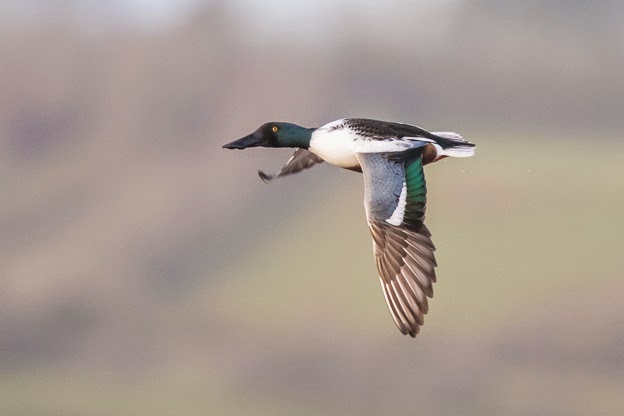RSPB Greylake on Wednesday was battered by a "howling gale" - surely there must be a less hackneyed and more telling expression than that to describe the strength of the wind. What about, "windy enough to have the ducks flying backwards". In fact, that was pretty close to the truth. I watched a pair of Mallard take off from one small pond and attempt to fly into the wind to land on the main scrape. For several seconds at a time they were making no headway at all - their ground speed was zero despite their furiously flapping wings. It looked like everything that got airborne was suddenly surprised by what they encountered. Consequently, most things seemed to prefer the shelter of the odd tuft of sedge and remained on the surface, head down.
The exposed "Treetop" hide was taking the full force of the Westerly gale. It shook, but not enough to make you think of jumping for dry land. Opening the windows however was a matter not to be undertaken lightly.
On this of all days I had arranged to meet well-known Somerset landscape, portrait and documentary photographer Pauline Rook to help her experience the pleasures of bird photography. Not a good choice of day, but Pauline remained cheerful throughout. Thank you Pauline!
We arrived at the Treetop hide and, guess what, opened the window. Wow! Whilst we were trying to move benches to find some shelter from the wind we noticed a Peregrine blow by at about a hundred miles an hour. Very shortly after I noticed it ploughing its way back up wind. Still engaged in essential housework I was not really prepared, but diving for the window I poked the camera out and pressed the button.
It says a lot for the new Canon 7D Mk2 autofocus system that it found something to take a picture of; it did not get much help from me. In fact it is the autofocus system on this new camera that has eventually persuaded me that it is a significant upgrade on the original, and still excellent, 7D.
If anyone is looking for a wildlife photography introductory bargain package they should, in my opinion, snap up (if they can still find it) one of the brand new original 7Ds, plus an original Mk1 100-400mm telephoto lens. Total cost not much more than £1000 at current give-away prices. Be quick though.
Here is another shot of the labouring Peregrine.
That was the main excitement of the day. I stayed on for an hour and a half after Pauline had sensibly left. Just a few opportunities presented themselves. It was disappointing to see how few ducks were at Greylake that day. Less than a tenth of recent flock numbers in my estimation.
I think that Greylake duck numbers may recover when those scattered by the gale make their way back to the main scrape in front of the hides. I will be there again soon to check.
Meanwhile, please visit my website at www.johncrabb.co.uk and visit and "like" (if you do) my Facebook page at www.facebook.com/johncrabbwildlifeimages

















































